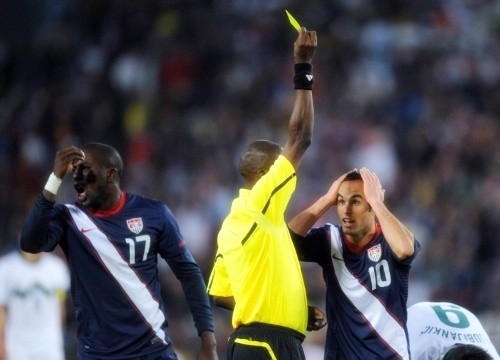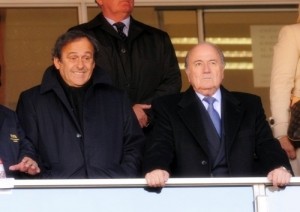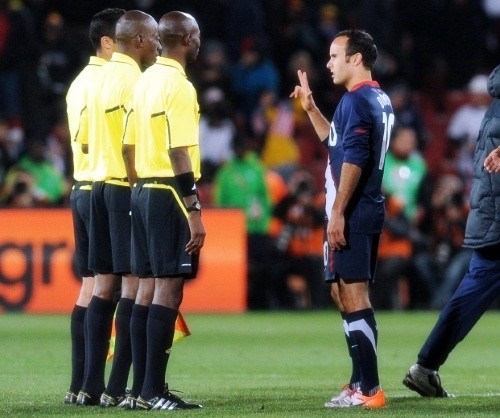Two years ago, I had the great pleasure to interview Ian Blanchard, Head of National Referee Development at the English FA, for Soccerlens. Mr. Blanchard sets the training standards for all professional English referees and evaluates them after each Premiership match. I would like to provide two excerpts from that interview:
In your opinion, what are the key attributes that a modern-day referee must have to be successful domestically and internationally?
“This same discussion came up in a workshop I was running in Malaysia for AFC Elite Referees.
It’s interesting that wherever you go in the world the general characteristics crop up as being essential to be a top quality referee.
You need to be a good communicator, not just of decisions made but equally important have the ability to get your message across to players, managers and spectators. You need to be a salesperson, just like selling a cart. You have to convince people you are confident in your ability to control the game and that your decision making is accurate. A high level of confidence is required, coupled with good knowledge on the laws of the game as well as the dynamics of football.
I also think you need an inner strength to cope with the pressure and expectations of the game. In adversity it is important you shake off negativity and concentrate on the positives of your performance. As I stated fitness plays an important part as does mental fitness. Referees are required to remain calm, controlled and develop high concentration levels to be successful.”

What do you think is the most misunderstood aspect of the refereeing profession by coaches, players, fans, and the media?
“I still think in a lot of cases there is a general lack of understanding of the laws of the game. I have attended pre-season meetings and been totally surprised by managers’ interpretations and mis-understanding of certain laws such as Law 11 covering offside. I think that raising awareness of everyone involved in the game concerning the role of the referee, how they go about their business, would go some way towards developing a degree of empathy.”

The 17 Laws of the Game
- 1 – The field of play
- 2 – The ball
- 3 – The number of players
- 4 – The players’ equipment
- 5 – The referee
- 6 – The assistant referees
- 7 – The duration of the match
- 8 – The start and restart of play
- 9 – The ball in and out of play
- 10 – The method of scoring
- 11 – Offside
- 12 – Fouls and misconduct
- 13 – Free kicks
- 14 – The penalty kick
- 15 – The throw-in
- 16 – The goal kick
- 17 – The corner kick
Interpretation of the Laws of the Game and Guidelines for Referees
Laws 5 and 6 detail the responsibilities of referees and assistant referees. I would like to highlight two sections quoting directly from FIFA’s own guidelines:
‘What needs to be seen’ is not always in the vicinity of the ball. The referee should also pay attention to:
- aggressive individual player confrontations off the ball
- possible offences in the area towards which play is heading
- offences occurring after the ball is played away.
Offences committed by two players from the same team:
- the referee must punish the most serious offence when players commit more than one offence at the same time
- play must be restarted according to the most serious offence committed
Offences committed by players from different teams:
- the referee must stop play and restart it with a dropped ball from
the position of the ball at the time of the stoppage, unless play was
stopped inside the goal area, in which case the referee drops the ball on
the goal area line parallel to the goal line at the point nearest to where
the ball was located when play was stopped.”
Proper Positioning on a Free Kick
FIFA had a special section that might be of interest given what happened at Ellis Park on Friday evening between the USA and Slovenia. On page 72 from the link below, there are four interesting graphical images about referee positioning on a free kick. The first shows where the match official should be for a free kick from the right side. We can’t reproduce the graphics here so please take a look when you have a chance.
Courtesy of FIFA.com, 2009/2010 Laws of the Game, pages 70-72.
The Example of Jim Joyce
The Enforced Silence of Koman Coulibaly

Holding an Opponent
“Holding an opponent includes the act of preventing him from moving past or around using the hands, the arms or the body.
Referees are reminded to make an early intervention and to deal firmly with holding offences especially inside the penalty area at corner kicks and free kicks.”
Courtesy of FIFA.com, 2009/2010 Laws of the Game, page 110.
Coulibaly and his assistants do not have to face the media, fans or managers. We are left wondering and have to wait for FIFA’s investigation because the governing body bars him or any match official from making any public statements.
A Learning Experience or the Status Quo at FIFA?
We need to recognize that mistakes happen at the highest levels in professional sports. Governing bodies can make life easier for all concerned. FIFA can learn from the situation at Ellis Park if they so desire. Or FIFA can enforce the status quo of silence.
Steve Amoia is a freelance writer, editor and translator from Washington, D.C. He writes the World Football Commentaries blog. He has written for AC Cugini Scuola Calcio (Italian soccer school), Football Media, Keeper Skool and Soccerlens.
Add Sportslens to your Google News Feed!